How Are Microbial Sensors Being Used to Detect Contaminants in Drinking Water?

The importance of clean drinking water is an undeniable fact. Contaminants, whether visible or invisible, pose a serious threat to human health. While there are numerous methods for detecting various types of contaminants in water, the focus today is on microbial sensors. These innovative devices are becoming increasingly effective and essential in identifying harmful substances such as bacteria and other pathogens in our water supplies. With keywords such as water, bacteria, detection, methods, sensor, particles, microbial, drinking, detect, pathogens, health, techniques, based, coli, method, used, and contaminants, let’s delve into the details of how microbial sensors are revolutionizing the world of water contamination detection.
The Fundamental Understandings of Microbial Sensors
Before discussing the ways microbial sensors are used to detect contaminants in drinking water, it’s essential to understand what these devices are. A microbial sensor is a device that uses bacteria, yeast, or other microorganisms to detect changes in environmental conditions. These sensors are particularly valuable in detecting harmful bacteria, such as E. coli, which pose serious threats to human health.
Cela peut vous intéresser : What will you find in the black mystery box? discover now!
Microbial sensors function by leveraging the organic reactions of these microorganisms to contaminants. When these organisms encounter specific contaminants, they respond in a way that changes the sensor’s properties. This response may be a change in color, temperature, or other easily measurable aspects, providing a clear indicator of the contaminant’s presence.
Techniques Involved in Microbial Sensor-Based Detection
There are several techniques used in microbial sensor-based detection methods. These techniques are designed to maximize the sensors’ effectiveness in identifying and alerting to the presence of contaminants.
Cela peut vous intéresser : What Are the Developments in AI-Assisted Rehabilitation Robotics for Stroke Survivors?
For instance, some sensors use what is known as a ‘biosensor’ approach. In this method, the presence of a contaminant triggers a biological response from the sensor organism. This response may involve the production of a specific protein or change in the organism’s metabolic activity. Detecting this change can indicate the presence of a contaminant.
Another common technique involves the use of particles, such as metal or organic material, which enhance the sensor’s ability to detect contaminants. These particles can bind to specific substances, causing a change in the sensor’s properties that is easily identified.
The Role of Google Scholar and Crossref in Advancing Sensor Technology
The advancement of microbial sensor technology would not be possible without the collective effort of scientists around the globe. Platforms like Google Scholar and Crossref play a crucial role in this collective effort.
These platforms provide a wealth of information, including research papers, articles, and studies that contribute to the development of microbial sensor technology. Researchers can use these platforms to share their findings, collaborate with others in the field, and stay up-to-date with the latest developments. This collaboration facilitates the continuous evolution and improvement of detection methods, driving innovation and improving water safety standards worldwide.
Real-World Application of Microbial Sensors in Water Contamination Detection
Microbial sensors have a wide range of applications in the real world. For instance, they are used regularly in water treatment plants to detect contaminants in drinking water. This practice ensures that water is safe for consumption and meets health regulations.
Moreover, microbial sensors are often used in environmental monitoring. They can detect contamination in rivers, lakes, and other water bodies, providing valuable data that can be used to protect ecosystems and public health.
In emergency situations, these sensors can also be used to quickly identify contaminants in water supplies. This rapid detection is crucial for preventing the spread of disease and ensuring the safety of affected populations.
The Impact of Microbial Sensors on Public Health
The use of microbial sensors has a profound impact on public health. By detecting contaminants in drinking water, these devices play a vital role in preventing the spread of diseases caused by harmful bacteria and other pathogens.
For instance, the detection of E. coli in drinking water can prevent outbreaks of gastrointestinal illness, which can be severe or even fatal. Early detection of this pathogen allows for immediate remedial action, thus protecting the health of the community.
Similarly, the detection of other harmful substances, such as heavy metals or toxic chemicals, can prevent a range of health issues. From neurological disorders to cancer, the early detection and removal of these contaminants can save lives.
In conclusion, microbial sensors represent a significant advancement in water contamination detection. Their ability to detect a wide range of contaminants quickly and accurately is crucial in maintaining safe drinking water supplies and safeguarding public health. As research continues and technology advances, these sensors are set to become even more integral in our fight against water contamination.
The Integration of Microbial Sensors in Water Distribution Systems
The application of microbial sensors extends beyond just laboratory settings. These devices are increasingly used in real-time monitoring of water distribution systems. In the context of drinking water supply, these sensors can provide timely and critical data about the water quality.
Microbial sensors are positioned strategically throughout the water distribution system. They are designed to continuously monitor the water as it flows through the pipes. Specific elements such as nucleic acid or organic carbon can trigger a response in the sensor if present. This response is logged and sent to a central monitoring system in real-time, ensuring continuous surveillance of the water supply.
One of the main advantages of microbial sensors is their capacity to detect microbial contamination quickly. In the United States, for example, a spike in E. coli levels in a water distribution system can trigger an immediate response. This includes informing the public, halting the supply of contaminated water, and initiating remedial actions.
Furthermore, these sensors can detect a wide variety of water contaminants, including bacteria, viruses, algae, fungi, and parasites. They can also detect chemical contaminants, such as heavy metals and pesticides. This versatility makes microbial sensors a vital tool in maintaining the quality of drinking water supply.
Utilizing Scholar Crossref and Google Scholar in Microbial Sensor Research
The world’s scientific community has been vital in the advancement of microbial sensor technology. Digital platforms like Google Scholar and Scholar Crossref have become essential tools for researchers in this field. These platforms house countless research papers, studies, and articles, providing a treasure trove of data that can be used to refine and develop this technology further.
Google Scholar and Scholar Crossref also facilitate collaboration between scientists across the globe. Researchers can share insights, methodologies, and findings, advancing our collective knowledge and capabilities in detecting water contaminants. This type of collaboration is essential in driving innovation and setting new water safety standards.
For instance, a study published on Scholar Crossref might detail a new technique for enhancing the sensitivity of microbial sensors. This knowledge could then be applied by other researchers or water treatment facilities, resulting in improved water quality monitoring worldwide.
Moreover, these platforms also provide a searchable database for the public. This feature empowers the public to learn more about their drinking water quality, the technologies used to monitor it, and the potential health impacts of various contaminants.
Conclusion
The use of microbial sensors in detecting contaminants in drinking water represents a significant step forward in public health protection. These devices, capable of real-time monitoring of water supplies, have made our water distribution systems safer and more reliable.
Furthermore, the communication and collaboration facilitated by platforms such as Google Scholar and Scholar Crossref have been instrumental in the technological advancement of microbial sensors. The knowledge shared on these platforms is driving innovation, fostering new detection techniques, and setting higher standards for water safety.
As our understanding of microbial contaminants and our technology continues to evolve, the role of microbial sensors is expected to become even more critical. These devices will continue to safeguard our water supplies, ensuring access to clean, safe drinking water for all. Technology, collaboration and public awareness are all integral in our ongoing fight against water contamination.
